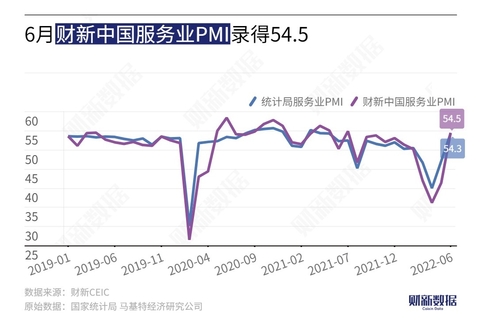Caixin China’s services PMI rebounded sharply in June to 54.5, the highest since August 2021
With the overall improvement of the epidemic situation, the relevant prevention and control measures have been gradually relaxed, the production and operation of the service industry have begun to resume, and the industry’s prosperity has risen sharply to the expansion range.

The June Caixin China General Service Industry Business Activity Index (Service Industry PMI) announced on July 5 recorded 54.5, a sharp increase of 13.1 percentage points from May, ending the three-month continuous contraction, and rose to 54.5. The highest since August 2021. This means that the service sector is starting to bottom out.
The previously announced June Caixin China Manufacturing PMI rebounded by 3.6 percentage points to 51.7; driven by the simultaneous recovery of the two major industry PMIs, the Caixin China Composite PMI rose by 13.1 percentage points to 55.3, the highest since January 2021. A new high, reflecting the resumption of growth in the production and business activities of Chinese enterprises.
The trend of Caixin China’s PMI is in line with the National Bureau of Statistics. The manufacturing PMI released by the Bureau of Statistics in June recorded 50.2, an increase of 0.6 percentage points, the service PMI increased by 7.2 percentage points to 54.3, and the comprehensive PMI rebounded by 5.7 percentage points to 54.1.
From the breakdown of data, both the supply and demand of the service industry have recovered. In June, the service industry business activity index and new orders index returned to the expansion range, and the improvement in supply was better than demand. Respondents said that with the easing of epidemic prevention measures, business activities have resumed, while the number of customers and consumption have increased, supporting the recovery of sales. However, the epidemic continued to dampen overall demand, and the number of new orders did not improve. On the external demand front, the new export orders index for the services sector fell into contractionary territory for the sixth consecutive month due to the coronavirus outbreak and travel restrictions.
Despite the improvement in supply and demand in the service sector, the employment situation has not improved significantly. Companies have reduced employment in order to cut costs, and the coronavirus outbreak has also caused some employees to leave, causing the service sector employment index to fall below the boom-and-bust line for the sixth consecutive month in June, although it rose slightly from the previous two months. The backlog of business volume index in the service industry was still above the threshold in June, but slightly down from May.
The cost increase of the service industry slowed down, and the sales price continued to rise slightly. The service-sector input price index fell to its lowest level in two years in expansionary territory in June, as lower raw material prices and labor cuts cut costs. The ex-factory price index for services was above the boom-bust line for the second month in a row, but the increase was slightly slower than in May. The survey shows that although some companies have increased their fee levels due to rising input costs, the market conditions are relatively sluggish and companies’ pricing power is limited.
Although business activities in the service industry rebounded strongly in June, the business expectations index was only unchanged from May, and some companies are still worried that future health events will continue to affect operations and customer demand.
Wang Zhe, senior economist at Caixin Think Tank, said that the health incident in June has been basically controlled, and relevant control measures have begun to be relaxed, and the production and operation order of enterprises has gradually returned to normal. stronger. . The resumption of work and production and the recovery of transportation and logistics are first reflected on the supply side. It will take time for demand to recover, the feedback from the job market has been delayed, the cost pressure of manufacturing enterprises is still high, and profitability is still facing challenges. Recovery in the post-pandemic period is still the main line of economic operation at present, but the foundation is not yet solid. The weak job market has led to the deterioration of residents’ income and expectations, which is the direct reason for the limited strength of market demand recovery. Therefore, it is suggested that the assistance and relief policies should focus more on enterprise employees, flexible employees and low-income groups affected by the epidemic.

